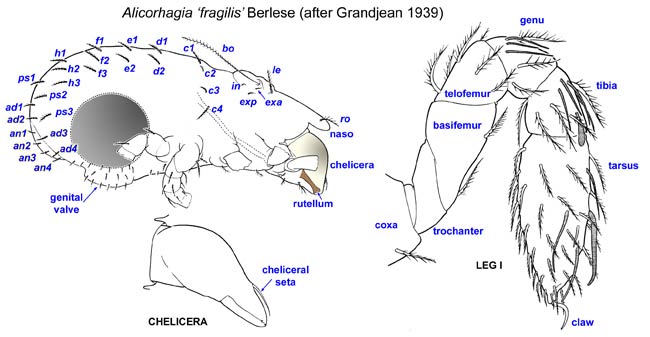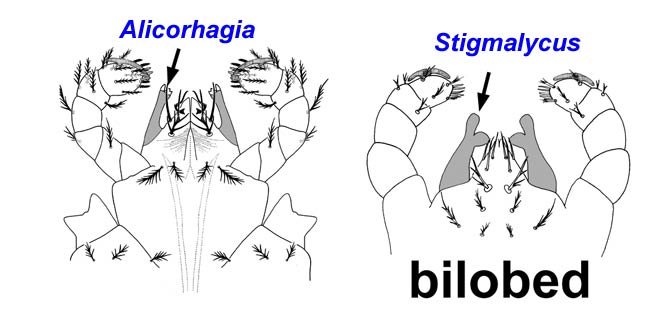
Home | Endeostigmata & Sphaerolichida Home | Glossary
Alicorhagia
Alicorhagia Berlese, 1910: 243.
Type species: Alicorhagia fragilis Berlese, 1910 – holarctic (= Willania mira Oudemans 1931)
Alicorhagia usitata Theron et al., 1970 – cultivated soil in South Africa; many soils in Australia; Alicorhagia clavipilus (Sig Thor 1931) – Europe ( = Epistomalychus clavipilus Sig Thor 1931); Alicorhagia plumipilus (Sig Thor 1931) – Norway; Alicorhagia ‘bullocki’ Shiba 1996
DIAGNOSIS. Prodorsum with 1 pair of filiform trichobothria (sci = bo) and 5 pairs of setae; naso well developed and bearing setae vi = ro; median and lateral eyes absent. Subcapitulum with 6 pairs of setae; rutella slender, with distal teeth; chelicerae chelate-dentate, each with one seta. Opisthosomal setal rows C-D-E-F-H-PS-AD-AN with 4-2-2-3-3-3-4-4 pairs of setae, respectively; PA absent. Genital flaps with 7-10 pairs of setae in 2 rows; 2 pairs of genital papillae in adult. All pretarsi with a simple, claw-like empodium; lateral claws absent. Gut boluses composed of fungal hyphae, spores, and bits of small, soft-bodied invertebrates.

REMARKS. Alicorhagia fragilis is omnivorous and readily prey on nematodes. Larvae, protonymphs and deutonymphs spin silken webs before moulting (tritonymphs do not occur). The thelytokous females spin silken webs on which the eggs are laid and hatch into an elattostatic prelarva (Walter 1988). It’s not clear that the mite so beautifully illustrated by Grandjean is the same as Berlese’s species; however, A. fragilis appears to be widely distributed in the Northern Hemisphere and A. usitata in the Southern Hemisphere.
SIMILAR TAXA. Species of Stigmalycus have bilobed rutella, are constricted behind legs IV, and have 3 pairs of genital papillae in the adults.

References
Evans, G. O. 1992. Principles of Acarology. CAB International, Cambridge.
Grandjean F. 1939. Quelques genres d’acariens appartenant au groupe des Endeostigmata. Ann. Sci. nat. Zool. 11(ser. 2):1-122.
Halliday, B. 1998. Mites of Australia, A Checklist and Bibliography. Monographs on Invertebrate Taxonomy Vol. 5. CSIRO Publishing, Collingwood.
Hirst S. 1923. On some arachnid remains from the Old Red Sandstone. Annals and Magazine of Natural History (9th Series) 12: 455-474.
Kethley JB. 1982. Endeostigmata. pp. 118-120, In: Parker SP (ed.) Synopsis and classification of living organisms. McGraw-Hill, NY.
Kethley JB. 1990. Acarina: Prostigmata (Actinedida). pp. 667-756, In: DL Dindal (ed), Soil Biology Guide. John Wiley & Sons, Brisbane.
Kethley, J.B., R.A. Norton, P.M. Bonamo & W.A. Shear. 1989. A terrestrial alicorhagiid mite (Acari: Acariformes) from the Devonian of New York. Micropaleontology 35: 367–373.
Livshits IZ, Mitrofanov VI. 1978. Alicorhagiidae, p. 97-98, In: Gilyarov, M.S. [Ed.] [Identification key of soil inhabiting mites. Trombidiformes.] Nauka, Moscow 1978: 1-270.
Norton RA, Kethley JB, Johnston DE & OConnor BM. 1993. Phylogenetic perspectives on genetic systems and reproductive modes of mites, in Evolution and diversity of sex ratio in insects and mites, pp. 8–99, eds DL Wrensch & MA Ebbert. Chapman & Hall: New York.
OConnor BM. 1984. 1. Speciation and evolution in Acari 1.2 Phylogenetic relationships among higher taxa in the Acariformes, with particular reference to the Astigmata. pp. 19-27, In: Griffiths, D.A. & Bowman, C.E. [Eds]. Acarology 6. Volume 1. Ellis Horwood Limited, Chichester.
Theron PD, Meyer MKP & Ryke PAJ. 1970. The family Alicorhagiidae Grandjean (Acari: Trombidiformes) with descriptions of a new genus and species from South African soils. Acarologia 12: 668-676.
Walter DE. 1988. Predation and mycophagy by endeostigmatid mites (Acariformes: Prostigmata). Experimental & Applied Acarology 4: 159-166.
Walter, D.E. and Proctor, H.C. 1999. Mites: Ecology, Evolution and Behaviour. University of NSW Press, Sydney and CABI, Wallingford. ISBN 0 86840 529 9
Zacharda M. 1978. Terrestrial prostigmatic mites from the Amateur’s Cave, the Moravian Kars, Czeckoslovakia. Vestnik Ceskoshoenské Spolecnosti Zoologické 42: 215-240.
Schuster R. 1979. Soil mites in the marine environment. Recent Advances in Acarology, Vol. 1: 593-602.
Theron PD. 1977. New species of the genus Petralycus Grandjean (Acari: Endeostigmata) from South Africa. Acarologia 19: 38-45.
Theron PD. 1979. The functional morphology of the gnathosoma of some liquid and solid feeders in the Trombidiformes, Cryptostigmata and Astigmata (Acarina). pp. 575-579 in E. Piffl (ed.), Proceedings of the 4th International Congress of Acarology. Akadémiai Kiadó: Budapest.
Thor S & Willman C. 1941. Acarina – 71a. Eupodidae, Penthalodidae, Penthaleidae, Rhagidiidae, Pachygnathidae, Cunaxidae. Das Teirreich 71: 1-186.
Vazquez IM. New species of Nanorchestes (Endeostigmata, Nanorchestidae) from sand beach at La Mancha, Veracruz, Mexico. (Especie nueva de Nanorchestes (Endeostigmata, Nanorchestidae) de arena de playa en La Mancha, Veracruz, Mexico.). Anales Del Instituto De Biologia Universidad Nacional Autonoma De Mexico Serie Zoologia 67(2): 205-211.
Walter DE. 1988. Predation and mycophagy by endeostigmatid mites (Acariformes: Prostigmata). Experimental & Applied Acarology 4: 159-166.
Walter, D.E. 2001. Endemism and Cryptogenesis in ‘Segmented’ Mites: A Review of Australian Alicorhagiidae, Terpnacaridae, Oehserchestidae and Grandjeanicidae (Acari, Sarcoptiformes). Australian Journal of Entomology 40: 207-218.
Walter DE & Proctor HC. 1998. Feeding behaviour and phylogeny: Observations on early derivative Acari. Experimental & Applied Acarology 22: 39-50.
Walter, D.E. and Proctor, H.C. 1999. Mites: Ecology, Evolution and Behaviour. University of NSW Press, Sydney and CABI, Wallingford. ISBN 0 86840 529 9
Womersley H. 1944. Australian Acarina, families Alycidae and Nanorchestidae. Transactions of the Royal Society of South Australia 68: 133-143.
Zakhvatkin AA. 1949. New representatives of apparently segmented mites (Acarina: Pachygnathidae). Ent. Obozer. Moscow 30: 291-295.